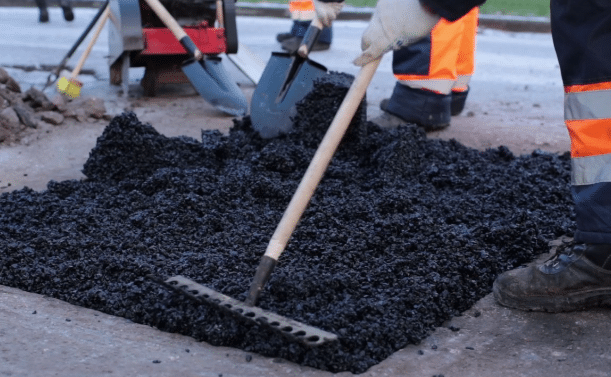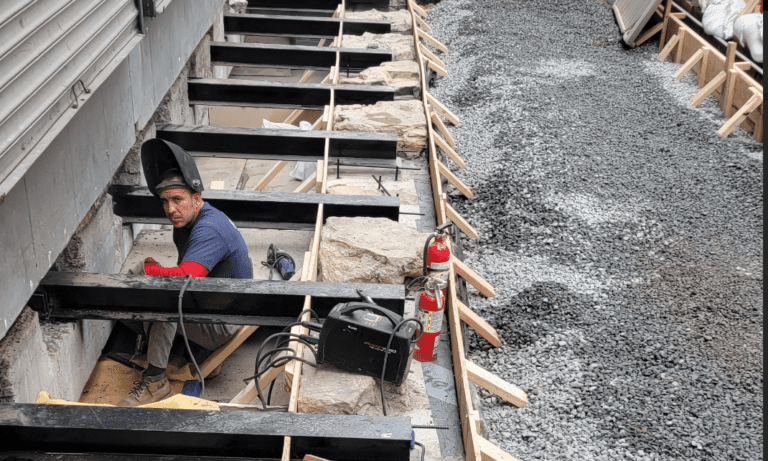Last Updated on January 23, 2025 by Jeffrey Calderon

Asphalt Paving: Essential Permit Requirements and Processes
Asphalt surfacing is a widely-used material for driveways and parking lots, due to its robustness, cost efficiency, and quick installation. This comprehensive guide will delve into the various aspects of asphalt pavement technology, ensuring that homeowners and contractors alike are well-equipped with the knowledge required for successful projects.
We will begin by exploring different types of asphalt mixtures used in pavements and their respective applications.
Next, we’ll discuss permit requirements that may be necessary depending on your location and project scope.
The preparation process is crucial to achieving long-lasting results; hence, we’ll outline best practices for site grading and drainage solutions.
Moving forward, our focus will shift to the installation process – from selecting appropriate compaction equipment such as vibratory rollers to understanding environmental conditions affecting hot mix asphalt application.
Lastly, we’ll cover essential maintenance techniques like chip seals which can prolong pavement life while minimizing repair costs over time.
Types of Asphalt Paving
Asphalt paving is the bee’s knees for homeowners and contractors in NYC due to its durability, cost-effectiveness, and ease of installation.
Different asphalt types, each with its own advantages and features, are available for residential and commercial projects in NYC.
Let’s dive into some common types of asphalt used for residential and commercial projects.
Hot Mix Asphalt (HMA)

Hot Mix Asphalt, or HMA, is the most commonly used type of asphalt in NYC.
It’s a mixture of aggregate materials like sand, gravel, or crushed stone combined with liquid asphalt cement at high temperatures.
This creates a flexible yet strong surface that can withstand heavy traffic loads and harsh weather conditions.
Porous Asphalt
Porous asphalt is an environmentally friendly option designed to allow water to drain through the pavement instead of pooling on top.
This reduces stormwater runoff while also providing better traction during wet weather conditions.
Porous asphalt is often used for parking lots or low-traffic areas where proper drainage is essential.
Cold Mix Asphalt (CMA)

Cold Mix Asphalt, or CMA, differs from hot mix because it’s mixed at lower temperatures using emulsified binders rather than traditional hot bitumen binders.
CMA has excellent workability properties making it ideal for temporary repairs, patching potholes, and other small-scale projects.
However, it’s not as durable as hot mix asphalt and is typically used for temporary fixes.
Warm Mix Asphalt (WMA)
Warm Mix Asphalt, or WMA, is a more environmentally friendly alternative to HMA.
It requires less energy to produce because it’s mixed at lower temperatures than traditional hot mix asphalt.
This results in reduced greenhouse gas emissions during production and installation.
WMA also offers better workability properties compared to HMA while maintaining similar performance characteristics.
Stone Matrix Asphalt (SMA)
Stone Matrix Asphalt, or SMA, is a high-performance type of asphalt designed for heavy traffic loads such as highways and major roads.
Its unique structure features a dense matrix of coarse aggregates held together by a strong binder system that provides excellent resistance against rutting and cracking.
Asphalt paving is a popular choice in NYC due to its durability, cost-effectiveness, and ease of installation. There are several types available including Hot Mix Asphalt (HMA), Porous Asphalt, Cold Mix Asphalt (CMA), Warm Mix Asphalt (WMA) and Stone Matrix Asphalt (SMA). Each type has unique characteristics and benefits suitable for different projects such as temporary repairs or heavy traffic loads on highways.
Permit Requirements for Asphalt Paving in NYC
Before you start your asphalt paving project in NYC, make sure you have the necessary permits from the DOT to avoid fines and ensure safety.
Types of Permits
- Street Opening Permit: Required for any excavation or opening of a street, sidewalk, or public place.
- Sidewalk Construction Permit: Needed for constructing or repairing sidewalks using approved materials.
- Curb Cut Permit: Necessary for creating a new driveway entrance that requires cutting into existing curbs.
- Pavement Restoration Permit: Issued when restoring pavement after utility work has been completed within city streets.
Fees and Application Process
Submit an application with supporting documents and pay fees based on location and duration. Check out the Miscellaneous Permit Fees page for more information.
Inspection Permits
Inspection permits may be required for projects that could impact public safety or infrastructure, such as excavating near gas lines, water mains, or sewer pipes.
Permit Expiration and Renewal
Permits have expiration dates and must be renewed if your project extends beyond the original timeframe to avoid penalties.
Preparation Process
Proper readying is an indispensable element for a seamless and resilient asphalt covering that will endure for many years.
- Site Inspection: Inspect the site to determine its condition and address any existing drainage issues or obstacles.
- Determining Materials: Choose the right asphalt mix based on climate conditions, traffic load, and aesthetic preferences.
- Scheduling Permits: Obtain all necessary permits from relevant authorities like NYC DOT.
- Preliminary Work: Create a stable base by removing old pavement, excavating soil if needed, grading the ground level appropriately, and compacting it using specialized equipment.
- Budget Estimation: Create a budget estimate for your project, considering materials, labor costs, and permit fees.
For optimal results, plan the project for a time when temperatures are consistently above 50°F (10°C) and there is minimal precipitation forecasted.
Working with experienced professionals who specialize in asphalt paving projects is highly recommended to ensure top-quality results every step of the way.
Installation Process
Installing asphalt paving in NYC requires careful planning and execution to ensure a durable and long-lasting surface.
Site Inspection
Before starting any work, conduct a thorough site inspection to identify any potential issues that may affect the project’s success.
Grading and Excavation
Remove existing pavement or soil to create a stable base for the new asphalt surface, ensuring proper grading to prevent water damage.
Base Material Installation
- Aggregate: Place a layer of crushed stone on top of the graded area to provide additional support for heavy loads.
- Compaction: Compact the aggregate base using specialized equipment to prevent future settling or shifting.
- Fabric Interlayer: Install an optional fabric interlayer between layers of HMA to improve bonding strength.
Asphalt Paving Application
Spread hot mix asphalt evenly over the prepared base using specialized paving machines and compact it with rollers for a smooth and even surface.
Joint Sealing
Seal any joints or seams between sections with hot rubberized crack sealant to prevent water infiltration that can lead to premature deterioration.
Final Inspection and Cleanup
Conduct a final inspection to ensure all work meets quality standards and perform necessary cleanup before your new asphalt surface is ready for use.
For more information on asphalt pavement construction, check out this credible source.
Maintenance and Repair
Periodic assessment of your asphalt surfacing is essential to maintain its performance and durability, while also helping you save costs in the long run.
Regular Inspection
Periodically check the asphalt for signs of harm or deterioration, like splits and potholes, and keep an eye on runoff systems to prevent water collecting on the top.
Sealcoating
Apply a protective layer over the pavement’s surface every 2-4 years to protect it from UV rays, chemicals, water infiltration, and general wear-and-tear.
Crack Filling & Patching Potholes
- Crack filling: Address small cracks as soon as possible by cleaning them out thoroughly before applying a specialized crack filler material designed specifically for asphalt surfaces.
- Patching potholes: Repair potholes promptly by removing any loose debris, filling the hole with an appropriate asphalt patching material, and compacting it for a smooth finish.
Resurfacing or Repaving
If your asphalt paving is severely damaged, consider resurfacing or repaving entirely by removing the existing surface layer and replacing it with fresh asphalt material.
For more information on maintaining and repairing your asphalt paving, check out these resources: How To Fill Cracks In Asphalt Using Asphalt Crack Filler, National Asphalt Pavement Association – Resurfacing & Repaving, and Maintaining Asphalt Pavements.
FAQs in Relation to Asphalt Paving
Why is Asphalt Paving Important?
Asphalt paving is essential for creating a smooth, durable, and safe surface for both vehicles and pedestrians, while also improving curb appeal, increasing property value, and aiding in proper drainage. Additionally, asphalt is eco-friendly, recyclable, and helps reduce urban heat island effects.
Pros and Cons of Asphalt Paving
- Pros: Cost-effective, quick installation, low maintenance, and flexible in extreme temperatures.
- Cons: Limited lifespan (15-20 years), susceptible to oil stains and UV damage, and requires periodic sealing.
Common Problems with Asphalt Pavement
Asphalt pavement can experience cracking due to temperature fluctuations or heavy loads, potholes from water infiltration, rutting caused by traffic patterns, fading from sun exposure, and oil stains from vehicles.
What’s the Difference Between Asphalt and Paving?
Asphalt is a specific mixture of aggregates bound together using bitumen, while paving encompasses various materials like concrete, pavers, brick, cobblestone, and interlocking blocks used to create hard surfaces for driveways, sidewalks, patios, parking lots, and roads.
Both materials can be used, but the term paving generally implies a broader range of options, while asphalt is more focused on a particular type of material and process.
Conclusion
Asphalt paving is a crucial process for homeowners and contractors alike, and understanding the different types of asphalt and necessary permits is key.
Proper preparation, installation, and maintenance are critical for a successful project, whether it’s a personal driveway or a commercial endeavor.
By following best practices and credible sources, you can enjoy a smooth surface that adds value to your property for years to come.






